Important steps to check the safety of the car
check the safety of the Cars have become an integral part of our lives, facilitating our daily commutes and journeys. However, amidst the convenience, ensuring the safety of our vehicles remains paramount. Understanding the essential steps to evaluate and guarantee a car’s safety is crucial for every car owner.
Important steps to check the safety of the car
| Important Steps to Check Car Safety | Synonyms/LSI/NLP Terms |
|---|---|
| Seatbelt Inspection | Restraint Evaluation, Seat Restraint Check, Belt Examination |
| Tire Pressure Check | Tyre Inflation Assessment, Wheel Pressure Examination, Tread Depth Review |
| Brake System Inspection | Braking Mechanism Check, Brake Evaluation, Systematic Braking Analysis |
| Airbag Functionality Assessment | Air Cushion Verification, Safety Restraint System Evaluation, Bag Inspection |
| Lights and Signals Verification | Illumination Validation, Signaling Confirmation, Indicator Inspection |
| Fluid Levels Check | Liquid Status Assessment, Fluid Quantity Verification, Oil and Fluid Examination |
| Wiper Blade Evaluation | Windshield Wiper Inspection, Blade Function Check, Wiper Assessment |
| Engine Performance Check | Motor Function Assessment, Performance Validation, Powertrain Inspection |
| Safety Features Review | Security Elements Examination, Safety Measures Assessment, Protective Features Check |
| Vehicle Body Integrity Assessment | Structural Soundness Review, Body Condition Check, Frame Examination |
| Collision Damage Assessment | Impact Damage Evaluation, Crash Damage Inspection, Collision Analysis |
| Electronic System Verification | Electrical Mechanism Check, System Electronics Review, Digital Components Inspection |
| Steering System Examination | Directional Control Assessment, Steering Mechanism Check, Guidance System Inspection |
| Exhaust System Inspection | Emission Mechanism Evaluation, Exhaust Component Check, Fume Analysis |
| Suspension System Assessment | Spring System Evaluation, Suspension Mechanism Inspection, Shock Absorption Review |
| Vehicle Maintenance Review | Car Care Assessment, Maintenance Check, Vehicle Service Analysis |
| Safety Manual Consultation | Safety Guidelines Review, Manual Reference, Safety Protocol Evaluation |
| Road Test Conduct | Drive Assessment, On-Road Evaluation, Test Drive Execution |
| Emergency Kit Inspection | Crisis Preparation Check, Emergency Gear Examination, Safety Gear Review |
| Vehicle Identification Verification | Car ID Validation, Vehicle Confirmation, Auto Identification Review |
| Child Safety Seat Examination | Kid’s Restraint Assessment, Child Safety Device Inspection, Infant Protection Review |
| External Inspection | Exterior Assessment, External Review, Outside Inspection |
| Interior Examination | Inside Inspection, Interior Review, Cabin Assessment |
| Owner’s Manual Consultation | User Guide Review, Manual Reference, Owner’s Guide Examination |
See More:”Everything You Need to Know to Car Insurance“
Regular Maintenance Checks
- Engine and Fluids
- Brakes and Tires
- Lights and Signals
Structural Integrity Evaluation
- Body Inspection
- Rust and Corrosion
Safety Features Verification
- Airbags and Seatbelts
- Advanced Safety Systems
Professional Inspection Importance
- Certified Mechanics
- Pre-Purchase Inspections
Driving Habits Impact on Safety Checks
- Regular Driving Practices
- Defensive Driving Tips
Regular Maintenance Checks
Engine and Fluids:Regularly examining the engine’s health and fluid levels is fundamental. Engine oil, transmission fluid, brake fluid, and coolant levels must be regularly monitored and replenished as needed. These checks ensure the car’s optimal performance and prevent potential breakdowns.
Brakes and Tires
The condition of brakes and tires significantly influences a car’s safety. Periodically inspecting brake pads, rotors, and tire treads for wear and tear is imperative. Adequate tire pressure and the presence of any bulges or punctures should not be overlooked.
Lights and Signals
Ensuring all lights and signals are operational is essential for visibility and communication on the road. Regularly check headlights, taillights, turn signals, and brake lights to guarantee they are functioning correctly.
Structural Integrity Evaluation
Body Inspection
Examining the car’s body for any signs of damage, dents, or irregularities is vital. Any structural compromises might impact the vehicle’s safety in the event of a collision.
Rust and Corrosion
Rust and corrosion not only affect a car’s aesthetics but also weaken its structural integrity. Regularly inspecting susceptible areas for rust and promptly addressing it helps maintain the vehicle’s safety.
Safety Features Verification
Airbags and Seatbelts
The functionality of airbags and seatbelts can be life-saving in emergencies. Ensuring they are intact and functioning properly is crucial for passenger safety.
Advanced Safety Systems
Modern cars are equipped with advanced safety features like collision detection, lane departure warning, and adaptive cruise control. Regularly verifying these systems’ functionality guarantees enhanced safety during drives.
Professional Inspection Importance
Certified Mechanics
Seeking professional help from certified mechanics for regular maintenance and checks is highly advisable. Their expertise ensures thorough inspections and necessary repairs or replacements.
Pre Purchase Inspections
Before purchasing a car, conducting a comprehensive pre-purchase inspection is essential. It provides a detailed overview of the vehicle’s condition, ensuring a safe investment.
Driving Habits Impact on Safety Checks
Regular Driving Practices
Adopting safe driving practices contributes significantly to maintaining a car’s safety. Avoiding abrupt accelerations, maintaining safe distances, and adhering to speed limits are key factors.
Defensive Driving Tips
Practicing defensive driving techniques enhances safety on the road. Anticipating potential hazards, staying alert, and being mindful of surroundings minimize risks.
Prioritizing car safety through regular maintenance checks, structural evaluations, verifying safety features, seeking professional inspections, and adopting safe driving habits is indispensable. Taking these steps not only ensures personal safety but also contributes to overall road safety.
FAQs
How often should I check my car’s fluids?
Fluid checks should ideally be conducted every few months or as per the manufacturer’s recommendations.
Can I inspect my car’s safety features on my own?
While basic checks like seatbelt functionality can be done, a professional inspection ensures a comprehensive evaluation.
Is rust only a cosmetic issue on a car?
No, rust can weaken a car’s structure, compromising safety in the event of an accident.
What should I look for during a pre-purchase inspection?
A pre-purchase inspection should cover all vital components like engine health, structural integrity, and safety features.
How do defensive driving techniques improve car safety?
Defensive driving techniques enhance awareness and preparedness, reducing the likelihood of accidents.


